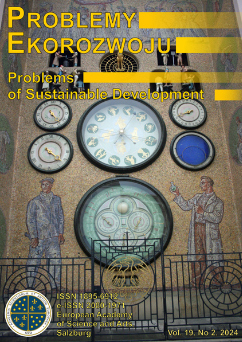Zrównoważony rozwój jako kompleksowe narzędzie pomiarowe: Przykład wybranych azjatyckich krajów rozwijających
Venkatesh G.
Researcher at the Norwegian University of Science and Technology, Trondheim (Norwegia)
Abstrakt
Podczas Szczytu Ziemi w Rio w 1992 podkreślono konieczność sformułowania wskaźników rozwoju zrównoważonego, które stanowiłyby istotną pomoc dla decydentów na wszystkich szczeblach. W niniejszym artykule, autorzy pokazują, jak skonstruować Holistyczny Krajowy Indeks Zrównoważoności, uwzględniając cztery filary zrównoważonego rozwoju – społeczny, ekonomiczny, ochronę środowiska i infrastrukturę. Badania odnoszą się do 12 azjatyckich krajów rozwijających, gdzie możliwość wprowadzenia rozwoju zrównoważonego będzie w nadchodzących latach kluczowym zagadnieniem. Porównanie krajów stosujących swoje własne indeksy nie miałoby sensu, nie chodzi tu o stany, w których kraje się znajdują w danym momencie, ale o ścieżki, którymi podążają w kierunku zrównoważoności. Mimo ograniczeń i pewnej subiektywności, taki Indeks (z uwzględnieniem jego braków), może być dobrym narzędziem planowania dla decydentów na wszystkich poziomach zarządzania.
Słowa kluczowe:
zrównoważoność, ekonomia, środowisko, społeczeństwo, infrastruktura, dochód, handel, rolnictwo, usługi, relacja eksport-import, oczekiwana długość życiaBibliografia
CABRERA E., 2008, Benchmarking in the water industry: a mature practice? in: Water Utility Management International, vol. 3, no 3, p. 5-7.
Google Scholar
CAMERON, R. & NEAL L., 2003, A concise economic history of the world, Oxford University Press, UK.
Google Scholar
ECONOMIST INTELLIGENCE UNIT (LONDON), 2009, European Green City Index – assessing the environmental impact of Europe’s greatest cities, Siemens AG, Munich.
Google Scholar
EHRENFELD J., 2009, Understanding of complexity expands the reach of industrial ecology in: Journal of Industrial Ecology, vol. 13, no 2, p. 165-167.
Google Scholar
EUROSTAT, 2007, Measuring progress towards a more sustainable Europe: 2007 monitoring report of the EU sustainable development strategy, Eurostat Statistical Books.
Google Scholar
GUHA R., 1992, Prehistory of Indian Environmentalism – Intellectual Traditions in: Economic and Political Weekly, vol. 27, no I,3, p. 57-64.
Google Scholar
HAJKOWICZ S. and COLLINS K., 2007, A review of multiple criteria analysis for water resources planning and management in: Water Resources Management, vol. 21, p. 1553-1566.
Google Scholar
INDEXMUNDI, http://www.indexmundi.com, Accessed many times in October 2013.
Google Scholar
IYER R R., 2010, Water – What must we do? Part of the book – Water: Culture, Politics and Management, Dorling Kinderseley (India) Private Limited, India, 2010.
Google Scholar
KALLIO T. J., NORDBERG P. & AHONEN A., 2007, Rationalising Sustainable Development – a critical treatise in: Sustainable Development, vol. 15, p. 41-51.
Google Scholar
KEIRSTEAD J. & LEACH M., 2008, Bridging the gaps between theory and practice: a service niche approach to urban sustainability indicators in: Sustainable Development, vol. 16, p. 329-340.
Google Scholar
MITCHELL G., 1996, Problems and fundamentals of sustainable development indicators in: Sustainable Development, vol. 4, p.1-11.
Google Scholar
PAWLOWSKI A., 2008, How many dimensions does sustainable development have in: Sustainable Development, vol. 16, p. 81-90.
Google Scholar
QUENTAL N., LOURENCO J. M. & DA SILVA F. N., 2011, Sustainable development policy: goals, targets and political cycles in: Sustainable Development, vol. 19, no 1, p. 15-29.
Google Scholar
SAVE THE CHILDREN, 2013, State of the World’s Mothers 2013 in: http://www.savethechildrenweb.org/SOWM-2013/#/1/zoomed (8.05.2013).
Google Scholar
SINGHIRUNNUSORN W & STENSTROM M K., 2009, Appropriate wastewater treatment systems for developing countries: criteria and indicator assessment in Thailand in: Water Science and Technology, vol. 59, no. 9, p. 1873-1884.
Google Scholar
THE ECONOMIST, 2013A, Poverty: The Decathlon Deprivation, The Economist Newspaper Limited, UK, March 23-29.
Google Scholar
THE ECONOMIST, 2013B, Infrastructure – The road to hell: Grounded – Special report on Brazil, The Economist Newspaper Limited, UK, September.
Google Scholar
THE ECONOMIST, 2013C. India’s informal economy – Hidden value, The Economist Newspaper Limited, UK, September.
Google Scholar
UNDP (United Nations Development Programme), 2011, Human Development Report 2011 – Sustainable and Equity: A better future for all, http://hdr.undp.org/en/media/HDR_2011_EN_Complete.pdf (31.03.2013).
Google Scholar
VENKATESH G., 2011, Global Logistics Hubs in: Logistics Insight Asia, Contineo Media, Singapore, April-May, p. 8-15,
Google Scholar
VENKATESH G., 2012, A critique of the European Green City Index in: Journal of Environmental Planning and Management, vol. 57, no 3, p. 317-328.
Google Scholar
VENKATESH G and BRATTEBO H., 2013, Typifying cities to streamline the selection of relevant environmental sustainability indicators for urban water supply and sewage handling systems, in: Environment, Development and Sustainability, vol. 15, p. 765-782.
Google Scholar
Autorzy
Venkatesh G.Researcher at the Norwegian University of Science and Technology, Trondheim Norwegia
Statystyki
Abstract views: 15PDF downloads: 6
Licencja

Utwór dostępny jest na licencji Creative Commons Uznanie autorstwa – Na tych samych warunkach 4.0 Miedzynarodowe.




